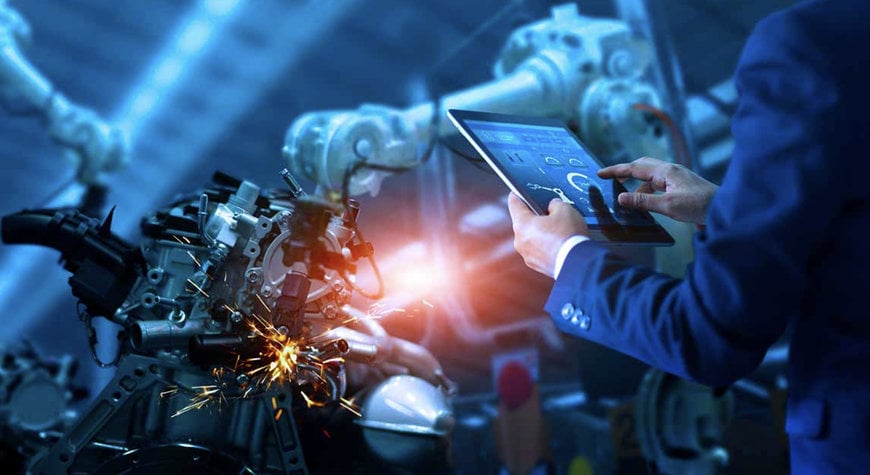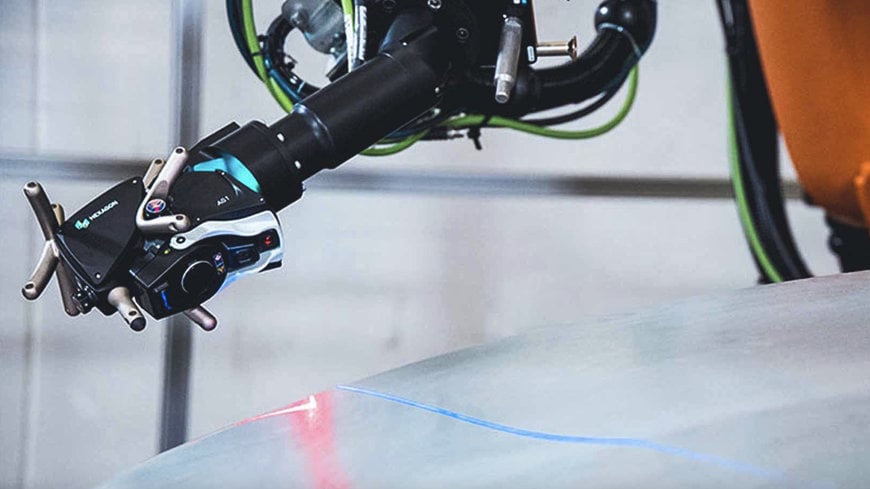www.ptreview.co.uk
02
'24
Written on Modified on
MANUFACTURING AUTOMATION: HOW TO GET IT RIGHT
Nicolas Lachaud-Bandres, Global Product Manager, sCMM Automation at Hexagon Manufacturing Intelligence talks about implementing manufacturing automation.
hexagon.com

Manufacturing automation is a powerful tool for enhancing productivity and efficiency, but implementation is not straightforward.
To make the most of an investment into automated systems, we need to be aware of some common misconceptions and understand where it can go wrong.
People often romanticise about the golden days of manufacturing, where products were built by skilled craftsmen, assembled by hand and finished with painstaking attention to detail. It’s common to hear phrases like “These days it’s all just automated”.
Within that little word “just” is a world of myth and misconception. It takes a lot of skill and knowledge to harness the power of automation, to understand the processes involved, the technology, the robotics and you need a broader understanding of the product lifecycle. After all, manufacturing automation is more than replacing human effort with machines or software, it’s about optimising entire processes to increase efficiency, and quality and reduce costs.
The issue – Integrating with current technologies
The latest research into this area suggests that the main challenge organisations face when investing in advanced manufacturing automation is the difficulty integrating the new technology into their existing equipment.
New technology might not be immediately compatible with existing systems. This could require significant modifications which take time and resources. Compatibility can take several forms, for example the new technology might require different operating systems or support infrastructure; it might require new protocols or data formats and there might also be physical compatibility issues integrating new equipment into an existing production line or factory layout.
Getting integration right
Ensure compatibility before you commit. Conduct a comprehensive system audit covering all existing tools, software and processes to understand your current infrastructure. This will give you a detailed knowledge of your starting point and will help you make the right decisions to ensure new technologies align with your legacy systems.
Choose the right vendor, one with experience and knowledge of your business sector and who understands your requirements. They should offer you systems that integrate with as little difficulty as possible, and they should provide the necessary training and support to get you through the transition and beyond.
Make sure you involve the right people from the start. Make sure to include your IT and any other relevant technical teams from the very beginning of the project, they will bring different points of view to the project and their technical knowledge will be critical in identifying compatibility issues.

The issue – Lack of funding or budget
Our Advanced Manufacturing Report showed that lack of funding or budget is a major barrier to entry for 32% of our sector. Manufacturing automation systems, especially advanced ones can require a substantial upfront investment. Misinterpretation of the initial outlay will disrupt the process before it has even begun.
Beyond the initial investment, the cost of integration is often underestimated. Expenses may be incurred by operational downtime during the installation phase and there will be the cost of acquiring new skills into the organisation – through bringing in consultants, training and hiring new staff.
Getting upfront budget visibility
To avoid this pitfall, it’s important to consider the total cost of ownership in combination with a full risk assessment. This assessment is often referred to as the “actual cost” because of its comprehensive nature across the entire lifetime of the product.
The total cost of ownership will be different for every organisation. In general terms, the following factors make the basis of an assessment:
- Initial planning
- Development and acquisition
- Integration
- Maintenance and upgrades
- Retirement
Each stage needs to be considered separately and as we look further into the future there will be a greater degree of uncertainty.
While this model provides a helpful framework for cost-profit analysis, it relies on predictions and estimations and therein lies the importance of a full risk assessment. It’s crucial to budget for occasions when things don’t go to plan and create a financial cushion for unknown expenses.
It’s better to conduct the assessment and stall your automation investment than it is to forge ahead without a fully costed and financially viable plan.
The issue – Security concerns
Adopting automated systems often means building networks of interconnected technologies. Instead of many smaller, isolated systems, we now have fewer but larger integrated ones. While this brings efficiency and productivity benefits, if not managed correctly it can introduce vulnerabilities and security risks with the potential to impact more systems. Your IT department will prove to be a great asset. They will have the experience and knowledge you need to protect against security concerns.
A single weak link, like outdated software or poor access control, can endanger the whole network. Some of the key benefits of automated manufacturing are around precision and consistency. However, if systems are compromised in some way, these benefits can quickly disappear.
The worst case scenario, an intentional cyber-attack, is thankfully very rare. With the right planning and procedures in place, the risks of a security breach can be mitigated.
How to get secure
Security is everybody’s concern and that means setting a positive example from the top down. Regular training is vital to keep staff up to date with the latest best practices but many of the skills and knowledge may already exist within the organisation. Make sure to involve your IT department from early planning stages. They will have a comprehensive knowledge of the system architecture, and know where potential vulnerabilities may arise
Cloud systems provide many security advantages like backups and disaster recovery protocols. Cloud security measures are also scalable, so they provide consistent protection as demand increases.
We recommend using a centralised system, like Nexus, to orchestrate all your operations from a single location. This level of control significantly enhances oversight, allowing for quick identification of and response to any system integrity issues.

The issue – Skills and knowledge
Part of the reason many organisation move to incorporate automated processes in their operations is to address concerns surrounding the skills gap in the technology sector. Ironically, many respondents in our research also cited a lack of skills and knowledge as a barrier to investing.
Implementing manufacturing automation is a complex challenge that involves sophisticated technology. Organisations are justified in their concerns about having the right skills and knowledge to make it work. There’s operations management, change management, training and development, integration, implementation and cyber security to consider – all of which are critical to the overall success of the project.
Getting the right skills in manufacturing automation
Work out what skills you need to make a success of the project. Understand your current situation and then identify where gaps exist. Depending on the results of your skills assessment, you’ll need to consider how and where to bring the right skills into the organisation. That might be through hiring new people or upskilling your current staff.
Where possible and appropriate, it’s preferable to invest in training and development of your current employees before seeking new staff. This is an excellent way to encourage buy-in and acceptance of the changes that implementing automation will inevitably entail.
By recognising the importance of acquiring the right skills and knowledge, your approach to automation will be more strategic. It will be more effective and more likely to achieve a strong return in a shorter space of time. It’s about building a team that’s aware of how to use automation technology, but also understands how it can be leveraged to achieve better organisational efficiency and productivity.
While this model provides a helpful framework for cost-profit analysis, it relies on predictions and estimations and therein lies the importance of a full risk assessment. It’s crucial to budget for occasions when things don’t go to plan and create a financial cushion for unknown expenses.
It’s better to conduct the assessment and stall your automation investment than it is to forge ahead without a fully costed and financially viable plan.
The issue – Security concerns
Adopting automated systems often means building networks of interconnected technologies. Instead of many smaller, isolated systems, we now have fewer but larger integrated ones. While this brings efficiency and productivity benefits, if not managed correctly it can introduce vulnerabilities and security risks with the potential to impact more systems. Your IT department will prove to be a great asset. They will have the experience and knowledge you need to protect against security concerns.
A single weak link, like outdated software or poor access control, can endanger the whole network. Some of the key benefits of automated manufacturing are around precision and consistency. However, if systems are compromised in some way, these benefits can quickly disappear.
The worst case scenario, an intentional cyber-attack, is thankfully very rare. With the right planning and procedures in place, the risks of a security breach can be mitigated.
How to get secure
Security is everybody’s concern and that means setting a positive example from the top down. Regular training is vital to keep staff up to date with the latest best practices but many of the skills and knowledge may already exist within the organisation. Make sure to involve your IT department from early planning stages. They will have a comprehensive knowledge of the system architecture, and know where potential vulnerabilities may arise
Cloud systems provide many security advantages like backups and disaster recovery protocols. Cloud security measures are also scalable, so they provide consistent protection as demand increases.
We recommend using a centralised system, like Nexus, to orchestrate all your operations from a single location. This level of control significantly enhances oversight, allowing for quick identification of and response to any system integrity issues.

The issue – Skills and knowledge
Part of the reason many organisation move to incorporate automated processes in their operations is to address concerns surrounding the skills gap in the technology sector. Ironically, many respondents in our research also cited a lack of skills and knowledge as a barrier to investing.
Implementing manufacturing automation is a complex challenge that involves sophisticated technology. Organisations are justified in their concerns about having the right skills and knowledge to make it work. There’s operations management, change management, training and development, integration, implementation and cyber security to consider – all of which are critical to the overall success of the project.
Getting the right skills in manufacturing automation
Work out what skills you need to make a success of the project. Understand your current situation and then identify where gaps exist. Depending on the results of your skills assessment, you’ll need to consider how and where to bring the right skills into the organisation. That might be through hiring new people or upskilling your current staff.
Where possible and appropriate, it’s preferable to invest in training and development of your current employees before seeking new staff. This is an excellent way to encourage buy-in and acceptance of the changes that implementing automation will inevitably entail.
By recognising the importance of acquiring the right skills and knowledge, your approach to automation will be more strategic. It will be more effective and more likely to achieve a strong return in a shorter space of time. It’s about building a team that’s aware of how to use automation technology, but also understands how it can be leveraged to achieve better organisational efficiency and productivity.

